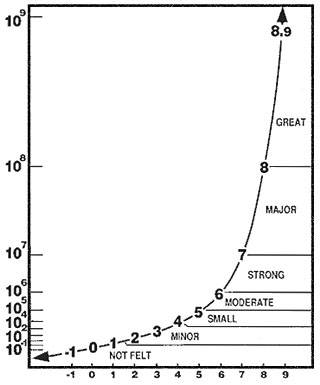Course:MATH110/Archive/2010-2011/003/Teams/Geneve/Homework 13/Logarithmic scale
Richter scale and it's relation to logarithmic functions:
Simply put the Richter scale measures the amount of energy released by an earthquake, and translates it to a number between 1 and 10, telling us the overall magnitude of the earthquake.
This energy is recorded from resulting vibrations(waves) in the earth, by an instrument known as the "seismograph". Measuring the highest amplitude of the vibrations/waves we can calculate how much energy was released, it goes to say the more energy released, the higher the amplitude of the waves. In essence the amplitude measured will tell us the amount of energy released, which in turn will tell us the magnitude/strength of the earthquake.
But how do we go from amplitude to energy to magnitude?
Magnitude, when simplified as numbers from 1 - 10, does not give the actual calculated magnitude of an earthquake. Each increment increases by a factor of one, when in reality each increase (4 to 5, or 5 to 6) indicates an intensity 10 times stronger than the previous number[1]. Ie: Earthquake of magnitude 5 is 10 times stronger than one of magnitude 4. These numbers increase exponentially, and not being so user friendly, it is scaled from 1-10.
Formula given for the Richter scale is:
Using your logarithm rules it can also be written as:
amplitude of the earthquake (taken from 100km from where the vibrations originated - measured from the surface above where the vibrations originated).
Intensity of the smallest sized activity measurable, hardly detectable (if you were to actually have an earthquake this size and put it on the Richter scale it would = 0. Can you figure out why by looking at the formula?). This is denoted as 1 micron or cm[2]
Why do we need . It gives us a reference value relative to our actual measured earthquake.
Example
If an Earthquake has an amplitude of 554.82 cm, what is the magnitude on the Richter scale?
Since we know that the smallest size of activity measurable is cm, we are able to use this information to get:
If each increase by one on the Richter scale represents an increase 10 times more intense than the last number, then an amplitude of 5548.2 cm should give a magnitude of 7.7441...:
This shows that the Richter Scale is logarithmic, although the numbers on the scale increase exponentially in terms of intensity.

The increase on the Richter Scale by increments of 1 is shown on the graph in terms of increase in intensity, and shows the graph increasing exponentially. The increase in intensity between for example 7 to 8 is similar to the example above.
References:










